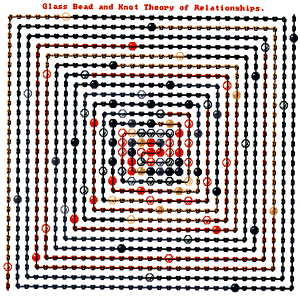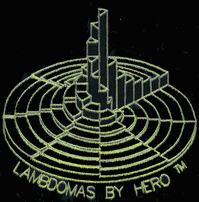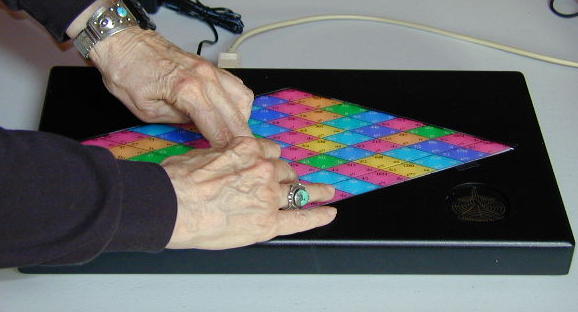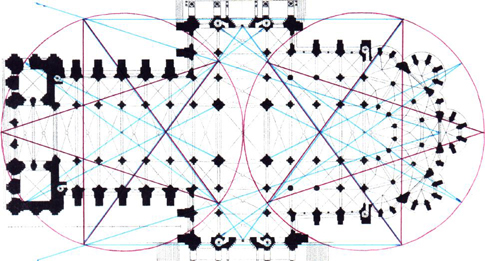Lambdoma Q&A with Barbara Hero (page 2)
TRANSLATIONS ~ English to: 
Please read and agree to the copyright attribution requirements at the bottom of this page before integrating any of these concepts into your own work. ヅ
Find more answers on this Lambdoma Blog created by Barbara Hero
I've been finding the information about the frequencies of the different parts of the body etc very interesting, but was wondering how it is measured & what scale it is measured in ie hertz per second.
The frequencies of the different organs of the body were provided by ultrasonic frequencies from one of the hospitals in my area. I then calculated the frequencies to be in musically audible reference octaves. The Hertz frequencies fall between the cracks of a piano keyboard so the scale is not a familiar one in the Western world.

My drawing on the cover of my book "Glass Bead and Knot Theory of Relationships" is a Lambdoma diagram of octaves that starts at the center and continues in a square spiral. It is definitely a Gann Square.
Do you feel it would be accurate to say that to arrive at a true 'signature' resonant freq for a shape whether it is 2d or 3d such as a room, that we sum all relevant component freqs derived from the angles, and various dimensions such as length, width, etc.... for instance how accurate would it be in your opinion, to say we have determined the actual signature resonant freq for a room by adding all the angle freqs + length freq +width freq +height freq, does the sum of all these adequately represent such or is some other formula method required. Unsure if you are familiar with Royal Rife, Priore or Beardens works, but they seem to think for instance that each material object such as a 'wine glass' has its own literal and unique 'identifier stamp', a resonant freq that actually defines it in time / space, etc... by knowing the unique stamp the object itself can be spefically modulated / engineered...
Yes, I am familiar with Rife's work as well as Tom Bearden's work. Each object or room has its own resonant frequency.
When the frequency is in tune (in unison) with the object it resonates. You might have a formula that is somewhat like this:
R = (ˆl^3 + w^3 + h^3 + a^3) where R = resonance; lwha = length, width, height, and angle cubed. You can play around with this concept and might come up with something that works.
I have been looking for recommended books to read on sound healing.Can you recommend any?
I am also looking for somebody to tell me how to measure the frequency of a vibrating item such as a Tibetan bowl or a ringing bell.
I am currently doing Hypnotherapy and I would like to incorporate these healing sounds in my therapy.
If you search the web look for Jonathan Goldman. He has books on "healing with sound." Don Campbell is another, as is Fabian Mamon, Kay Gardiner, and many others.
About measuring the frequency of a Tibetan bowl or a ringing bell. You could buy a frequency counter from an electronics firm and a contact microphone. The frequency counter would give you a digitized read out. If you want only the notes of a scale a simple musician's tuner (at a music store) would allow you to recognize the notes. Perhaps you could find other method on the internet.
I want to thank you for spending time on my approach on the Chartres Labyrinth.
The results you mention are quite remarkable and a real inspiration for me to continue my research.
I am not a mathematician or musician, but mostly use my intuition regarding my attempts to find the true harmony (numerical, geometrical or otherwise) inside various ancient monuments.
Perhaps this 'unbiased' approach has some major advantages, perhaps not.
Up until now, I have used the geometrical composition which I found inside the Labyrinth as a Key to 'unlock' the geometrical peculiarities of the groundplans/features of several ancient structures like: The Giza-complex, The Angkor-complex, Borobudur and the groundplan of Chartres Cathedral.
Geometrical/astronomical- speaking, all mentioned structures have some very striking things in common.
By applying the labyrinthine Key, they all reveiled a geometrical 'clockwork' which demonstrates ancient knowledge about the cycle of Precession.(25.920 years) Measured against this astronomical cycle however, they also demonstrate an even larger cycle of 34.560 years, which comprises a series of 16 zodiacal signs (or 4/3 parts of the cycle of Precession).
The geometry of the groundplan of Chartres Cathedral certainly embodies and demonstrates this larger cycle.
When I saw your illustration of the resonances inside this Cathedral, I instantly recognized some patterns that are very familiar to me.
With the reversed and mirrored nature of the two halves of the 'straightened' labyrinthine path in mind, the groundplan of this place makes a lot of sense, for if we draw a line through the centre of both Transepts and then 'mirror' the location of the Labyrinth towards the Choir, the form of the Labyrinth fits snuggly inside the semi-circular part of the Choir, at the spot where 'the other source near the altar-area ' is situated.
To me the Lambdoma Matrix makes a lot of sense and certainly strikes some chords with me. I've attached a graphic of a part of the geometrical clockwork of Chartres for clarification.
Again, thanks for spending time on the Labyrinth. ~ Huub Klaassen
It almost looks as though the dimensions of the Great Pyramid is the central pyramid in your drawing superimposed on the Chartres Cathedral.
So 25,920*4/3 = 34560. A ratio of 4/3 is a musical fourth in music. This means that the precession of 25,920 years is the ratio of 1/1. That means that 272.2Hz a C#/Db is the 1/1 ratio. That particular frequency reduced to a reference octave in music is the same as the orbit of our planet around the sun. It also represents one of the DNA clusters of C# researched by Susan Alexjander.
Thank you so much for your insight and your very important key to "unlock" so many geometrical peculiarities of ancient groundplans. If you work our the ratios for each of the 16 zodiacal signs, you would have a very important musical matrix.
Your website is magnificant. I wanted to add some things that stimulated me after reading your chapters. Perhaps these will mean something to you as well.
You mentioned looking for the angles. The musical and ratio equivalents of the angles (when the fundamental is 256Hz (C)) are:
30 degrees = 7/12 [12th subharmonic](D),
36 degrees = 8/11 [11th subharmonic] (Gb),
54 degrees = 7/5 [5th subharmonic] F#,
60 degrees = 7/4 [4th subharmonic] A+.
Also, by octave reduction 25,920 years = an F musically, while 34,560 years = a C musically. This means that F at a ratio of 1/3 is a subharmonic of C at a ratio of 1/1. That is a wonderful sounding harmonic.
Also, 2160 years (F) is an octave reduction of 34,560 (F) by halving 4 times. 30 degrees (A) is 5th harmonic of F. This means that there is a harmonic chord of FAC (1st,5th,3rd) that is based upon the two precessions and the 30 degrees.
You mentioned in the introduction that 23.5 degrees is the plane our planets rotate around the sun . 24 degrees = 4/9 (ratio) = Bb. The setting and rising sun at about 80 degrees =11/2 (ratio) = F. Bb is a harmonic of a third 3rd or 3/2. The chord would be F, Bb, C, a traditional wonderful harmonic, that includes both precessions as well as the 24 degree plane of the planets.
From: "William S. Buehler"
Subject: Klaassen labyrinth graphics
Here are the 3 [Klaassen labyrinth graphics] he gave me. He also sent this note which you might use:
In order to give you some idea of my work so far, I will give you a synopsis of my way of approach.( we can always go into this in further detail if you wish so). I started out with the form of the circular Labyrinth as it is present in Chartres Cathedral. Since this circular form has an almost 'hypnotising' effect on any onlooker, it is extremely difficult to examen it more closely.
The circular form can easily be devided into four quadrants and doing so, I found that the seperate loops of the path never exceed more than two quadrants. This gave me the idea to try and 'straighten' these curved loops so I could investigate them more closely without the 'hypnotising effect'. The stunning result of this 'straightening' was an image of the labyrinthine path which harboured the most perfect properties.
After having established this true baseline of the Labyrinth this way, the geometry almost automatically took over and the entire Labyrinth seemed to come alive somehow in a most spectacular way. Every geometrical form seemed to dictate the form, position, direction and proportion of the next one and so on. This went on until the entire composition was completed and the end-result radiates a sense of perfect balance and proportion. Several line-ups exist inside this composition, especially between the hexagram and the pentagram and both suggest a delicate geometrical interplay inside the composition which proves to be based on the values of the Golden Number.
The Labyrinth can be approached in two ways : one way works as is mentioned above and results in this geometrical composition ; The other way is to construct this composition in a purely geometrical way, starting out with a small circle.
As soon as the composition is completed this way, the lines of the various geometrical forms will generate the same baseline on which the Labyrinth is constructed.
All that is needed here is a pair of compasses, a ruler and a good sense of logic and precision.
The baseline of the Labyrinth is a wonder in itself : although it is one line, it exists out of two line-halves which are the exact reversed and also mirrored images of each other.
Much encouraged by this 'geometrical revelation' , I have tested the geometrical interplay of the Labyrinth on the lay-out or ground- plans of several ancient structures like : the Giza complex, Angkor, Borobudur etc. To my great astonishment they all readily reveiled their true nature, namely : inside the geometry of these places, a most beautiful and incredibly clever astronomical 'clockwork' is preserved which ticks away the seasons of the heavens, in this case an unknown cosmic cycle that comprises 34.560 earth-years.
All ancient structures on which I applied this labyrinthine key gave exactly the same result.
We know that, with regard to precession, the space of one Zodiacal sign on the Ecliptica comprises a timespan of 2.160 years.
Where one complete cycle of Precession comprises 12 x 2.160 = 25.920 years, this cycle of 34.560 years comprises 16 signs.
When tested on the groundplan of Chartres, here also (and very much to my surprise) the geometry of the place generated an exact timespan of 34.560 years and I most strongly believe that the 16 Grail Kings that you mention are of extreme importance here.
The geometrical / astronomical clockwork at Giza gives as a startingposition of this large cycle a point in time when the Zodiacal sign of Leo formed the background of the sunrise on the morning of the spring-equinox (about 13.000 years ago).
When we take it that this starting position was in the middle of this Zodiacal sign, we can comfortably add another 1000 years to this (1080years to be precize) in order to arrive at the Rutans at a point in time when the sign of Leo began.
If the present large cycle indeed started with the Sign of Leo( as the clockwork at Giza indicates), this implies that the large cycle preceding the current one must have ended in the Zodiacal sign of Virgo. Seen in this light, the name-giving of most Gothic Cathedrals might have an additional and perhaps very special reason. All those who have worked so hard on restoring the ancient knowledge and have tried to bring this knowledge to a next and higher level may indeed and most apropriately be called true Children of the Virgin. (In a way you mention this yourself "Basically WE are the Templars, back to continue the work").
I am quite convinced that certain aspects of the ancient knowledge still linger in the geometry of the groundplans of the circular Templar churches. After 1307, most of them were taken down and were rebuilt in a more rectangular style. (Why exactly was this done?)
These are only some remarks and questions on the task at hand. I sincerely hope they will be of any help to you, the same as your labour is important for my understanding and way of approach. Ultimately we appear indeed to be working on the same task.
Bill Buehler
The geometry is certainly a square sine wave. This is quite a remarkable way of analyzing the Chartres Labyrinth.
His linear sine wave forms could also be a musical score, with the spaces being F,A,C,E, and the bars being E,G,B,D,F. You could make chords where two are together. It sounds great on the piano.
By the way, we have now manufactured a Pythagorean Lambdoma Harmonic Keyboard that allows one to play any given frequency in Hertz within an 8 by 8 matrix.
The Labyrinth score above could be translated into frequencies so that you might have: 341Hz(F), 341Hz(F)448Hz(A), 341Hz(F), 448Hz(A), 512Hz(C), 640Hz(Eb), 640Hz(Eb), 640Hz(E)525Hz(C), 640Hz(Eb).
I was comparing the Labyrinth to a Lambdoma Mandala a while back; you can see that information on my IIRI site.
If you scroll near to the bottom of the section above, you will find the Mandala of the sun and one of the earth. The color coding of the notes indicates a spiral. The color coding of the musical notes is: A = purple, B = magenta, C = green, D = orange, E = yellow, F = green, G = blue. I transposed a transparency of the Labyrinth over the Mandala of the sun and had interesting results. Perhaps there is a connection here to Klaassen's Labyrinth?
My research and reading has led me to the concept of "entrainment" that involves the ability of the more powerful rhythmic vibrations of one object to change the vibrations of the less powerful rhythmic vibrations of another object and cause them to synchronize its vibrations with the first object.
My question is: What makes the rhythmic vibrations of one object more POWERFUL than the rhythmic virbrations of another object?
The Lambdoma Keyboard is an example of entrainment. The fundamental frequency that you put in the 1/1 position controls all of the other ratio frequencies in the matrix. Realize that you may put any audible frequency in the 1/1 at any audible octave.
When a client chooses their favorite frequency out of Quadrant #1, his or her choice determines the more powerful vibration. It is this factor, I believe, that causes the entrainment that results in the client being able to access their "higher selves", "higher consciousness", etc. All the other frequencies in the matrix are governed by that chosen fundamental. I always use the "drone" feature in FTS in order to have the effects of entrainment. The drone feature is always present in LambdomaS. LambdomaS is is a very good simple program to use with a client.


